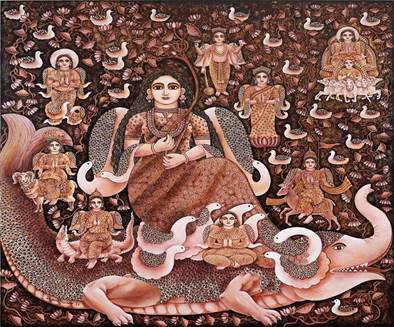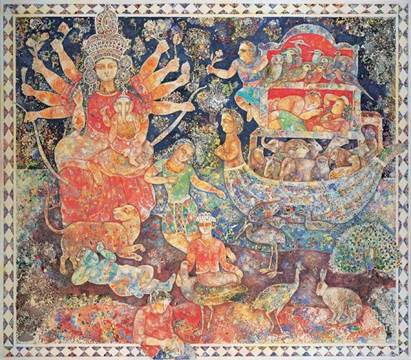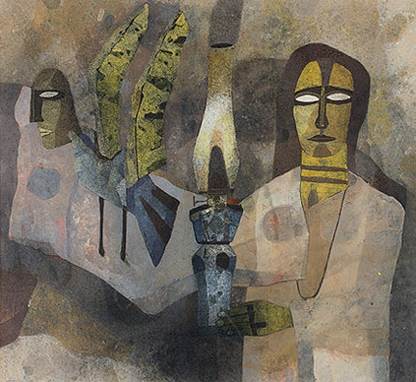ShodhKosh: Journal of Visual and Performing ArtsISSN (Online): 2582-7472
|
|
Application of hybrid figure in the Works of Queen Alexandra of Victorian Era and the Paintings from Indian contemporary artists: A Comparative Study
Pratap Manna 1![]()
![]() ,
Disha Mukherjee 2
,
Disha Mukherjee 2![]()
![]()
1 Assistant
Professor of School of Fine Arts and Design, Sister Nivedita University, India
2 Student, BFA, Amity University Kolkata, India
|
|
ABSTRACT |
||
|
Throughout history, art has been used to explore and
communicate the intricacies of human existence. One way this has been
achieved is through the representation of hybrid beings. These figures, which
combine attributes from various sources, have been a common theme across
cultures. The use of hybrid figures has allowed artists to delve into themes
such as identity, transformation, and the relationship between humans and
nature. This study aims to analyze the symbolism and meanings behind hybrid
creatures in Victorian-era photocollages and modern Indian artwork from
vastly different periods in art history. Objectives of the Research Study To investigate the reoccurring topic of hybrid
creatures in Victorian photocollages and contemporary Indian art. Examining the symbolism and significance of hybrid
beings, with a focus on identity, metamorphosis, and human-nature
interaction. Examining how hybridization is used by both art
genres to portray complicated notions about identity, social institutions,
and cultural interchange. Examining how artists use historical inspiration to
produce unique works and engage in cross-cultural discussion. Using commonalities in various art forms to
demonstrate the universal nature of artistic expression, transcending time,
location, and culture. Significance of the Research Study This study has significance because it investigates
the representation of hybrid beings in Victorian-era photocollages and modern
Indian artwork, providing insights into the symbolism and meanings associated
with hybrid creatures, specifically in the context of identity,
transformation, and the human-nature relationship. This study highlights the
continuing capacity of art to transcend chronological and geographical
barriers by examining how both Victorian photocollages and contemporary
Indian art use hybridity to express complicated notions about identity,
social institutions, and cultural exchange. It also highlights the artists'
ability to draw inspiration from the past, resulting in innovative works that
engage in cross-cultural dialogue, ultimately demonstrating the universal
nature of artistic expression and its profound impact on understanding the
complexities of human existence across diverse cultural and historical
contexts. Review of Literature To begin, researchers like Linda Nochlin and Griselda
Pollock have investigated the topic of hybridity in art, emphasising
its importance in subverting conventional concepts of representation. In her
important essay "The Imaginary Orient," Nochlin discusses how
Victorian-era art frequently included hybrid characters to address concerns
of cultural identity and colonialism. This point of view lays a solid
foundation for understanding the circumstances in which Victorian-era
photocollages evolved as a medium for creative expression. Scholars like Geeta Kapur and Partha Mitter have
explored the evolution of Indian art in the post-colonial era, highlighting
the use of hybridity as a tool for artists to negotiate cultural identity.
Homi Bhabha's "The Location of Culture" provides a theoretical
framework for understanding hybridity in Victorian-era and contemporary Indian
art. James Elkins' "Is Art History Global?" and "Globalizing
Art History" provide a contemporary lens for understanding
cross-cultural dialogues in art. |
|||
|
Received 15 May 2023 Accepted 14 December 2023 Published 20 December 2023 Corresponding Author Pratap Manna,
pratapmanna90@gmail.com DOI 10.29121/shodhkosh.v4.i2SE.2023.494 Funding: This research
received no specific grant from any funding agency in the public, commercial,
or not-for-profit sectors. Copyright: © 2023 The
Author(s). This work is licensed under a Creative Commons
Attribution 4.0 International License. With the
license CC-BY, authors retain the copyright, allowing anyone to download,
reuse, re-print, modify, distribute, and/or copy their contribution. The work
must be properly attributed to its author.
|
|||
|
Keywords:
Hybrid
Figure, Queen Alexandra, Victorian Photocollage, Indian Contemporary Art. |
|||
1. INTRODUCTION
1.1. VICTORIAN PHOTOCOLLAGES
During
the Victorian era, photo collages featuring hybrid characters were a popular
art form. These characters were a mix of human figures and elements from the
animal or plant world. The collages were made by combining several photographic
prints onto one larger image. This resulted in a strange and creative composite
image.
Artists
from that time were fascinated by the idea of hybridization, as it allowed them
to explore the connection between humans and the natural world, such as forests
and gardens. Many of these photocollages featured women with butterfly wings or
men with animal heads, like lions or eagles. These hybrid characters were often
placed in surreal settings like gardens or woodlands. Darwin (1951)
During
this period, Charles Darwin introduced his theory of evolution, which had a
profound impact on society and the arts. The idea that species could adapt and
evolve to new environments inspired painters and writers to create fantastical
creatures that combined traits from different animals. These hybrid beings
often symbolized the merging of different cultures, the potential of scientific
progress, and the power of human imagination.
The
debate surrounding Darwin's theories also sparked discussions about the
boundaries between species and the ethical implications of altering the natural
world. These themes were commonly explored in Victorian literature and art.
Figure 1

|
Figure 1 Marie-Blanche-Hennelle
Fournier (French, 1831–1906). Source https://www.metmuseum.org/exhibitions/listings/2010/victorian-photocollage/photo-gallery |
Julia
Margaret Cameron, famed for her portraits of ladies in extravagant costumes and
headdresses made of feathers or One of the most prominent things was flowers.
Victorian artists to deal with hybrid figures. Lady Clementina Hawarden,
another prominent artist, frequently portrayed her daughters in fantastical
positions, dressed in lavish costumes and accessories.
Figure 2

|
Figure 2 Clementina, Lady Hawarden. |
The
use of hybrid figures in Victorian photocollages not only allowed for an
exploration of the relationship between humans and nature but also pushed the
boundaries of artistic expression. These works were considered radical and
unconventional, as they challenged traditional notions of portraiture and
realism.
Figure 3

|
Figure 3 Kate Edith Gough (English, 1856–1948). Source https://www.metmuseum.org/exhibitions/listings/2010/victorian-photocollage/photo-gallery |
1.2. Indian Contemporary Paintings
Contemporary
Indian paintings often feature hybrid figures, which embody the country's rich
cultural heritage and diverse present. These figures combine elements from
various mythological, religious, and cultural traditions, resulting in a unique
visual language that reflects the complexities of modern Indian society.
Notable Indian artists such as Jaysri Burman, Sakti
Burman, Ganesh Pyne, and K G Subramaniam have all explored this theme in their
paintings. Dawkins (1995)
Jaysri Burman is renowned for her paintings which
showcase hybrid figures inspired by Indian mythology, tribal art, and nature.
These figures usually possess multiple heads, arms, and legs, and are adorned
with intricate patterns and symbols. Through her art, Burman delves into the
concept of the divine feminine, portraying it through the goddess figure and
the natural world. Falvo (2015)
Figure 4

|
Figure 4 Untitled by Jayasri Burman. |
Figure 5

|
Figure 5 Jayasri Burman, the ‘Resilient’
Ganga. Source https://timesofindia.indiatimes.com/blogs/plumage/jayasri-burmans-sculptures-revere-river-ganga/ |
Sakti
Burman incorporates a range of cultural and artistic influences, such as
European modernism, Indian miniature painting, and ancient Egyptian and Greek
art. His artwork frequently showcases hybrid figures that blend human, animal,
and mythical characteristics. Burman uses these figures to delve into topics
related to identity, spirituality, and transcending limitations.
Figure 6

|
Figure 6 Sakti Burman “Legends of Hope”.
Source
https://thecurators.art/products/sabusr08-sakti-burman-legends-of-hope |
Figure 7

|
Figure 7 Sakti Burman "Durga".
Source https://thecurators.art/products/sabusr01-sakti-burman-durga |
Figure 8

|
Figure 8 Ganesh Pyne "Untitled". Source https://abirpothi.com/painter-of-eloquent-silence-the-dark-surrealism-of-ganesh-pyne/ |
Ganesh
Pyne’s paintings also feature hybrid figures, but his approach is more surreal
and dreamlike. His figures are often depicted in a state of transformation,
melting into their surroundings or morphing into other creatures. Pyne’s
paintings are characterized by a dark, moody atmosphere, and a sense of mystery
and intrigue.
Figure 9

|
Figure 9 K G Subramanyan, Ethiopian
Nativity. Source https://www.documenta14.de/en/artists/13564/k-g-subramanyan |
The
paintings of Ganesh Pyne showcase hybrid figures, but his style leans towards
surreal and dreamlike. The figures he depicts are often in a state of
transformation, either blending into their surrounding or transforming into
other creatures. Pyne’s paintings are known for their dark, moody atmosphere
that exudes a sense of mystery and intrigue. Goswamy (2014)
K G
Subramaniam's paintings blend aspects of Indian and Western art to produce a
unique visual language that is both captivating and thought-provoking. His
figures are frequently abstracted and stylized, with exaggerated features and
vivid hues. Subramaniam employs his works to delve into topics such as
identity, culture, and the interconnections between humans and the natural
world.
1.2.1. SIMILARITIES
·
Compositional Settings
When
depicting hybrid figures, Victorian photocollages and Indian contemporary
paintings share many similarities in their composition. Both often mix together
human, animal, and mythological elements to create harmonious and balanced
hybrid figures. These figures are usually located in dreamlike landscapes or
mystical settings that encourage viewers to explore an otherworldly realm.
Victorian
photocollages produce hybrid figures by merging multiple images of humans,
animals, and objects in a visually appealing and psychologically compelling
manner. The figures seem to be suspended in mid-air, creating a sense of
movement and fluidity. Similarly, Indian contemporary painters such as Sakti
Burman, Jayasri Burman, Ganesh Pyne, and K G Subramaniam also use hybrid
figures to create surreal and mystical settings by combining different images
and forms. These figures are arranged in a way that creates a sense of movement
and fluidity, drawing the viewer's attention to different elements of the
composition. Both Victorian photocollages and Indian contemporary paintings use
symbols and metaphors to convey deeper meanings and emotions to the viewer.
These symbols may be personal or cultural, such as flowers, animals, and
religious icons for Victorian photocollages, or drawn from Hindu mythology for
Indian contemporary paintings. The composition of both art forms creates a
dreamlike realm that invites the viewer to explore. The use of light and shadow
adds to the depth and immersion in the scene. Melodysheep (2009)
·
Placing the Human Figures
Two
art forms incorporate a mix of human, animal, and mythological components to
generate surreal and fantastical worlds that blur the line between reality and
imagination. The placement of human figures in these compositions is crucial to
creating a sense of balance and harmony while conveying emotions and ideas.
Regarding
the depiction of hybrid figures, Victorian photocollages and Indian
contemporary paintings both utilize a blend of different images and forms to
create a single, unified figure. These figures are often a combination of
human, animal, and mythological elements, arranged in a way that produces a
sense of beauty. Photocollages create these hybrid figures by merging multiple
images of humans, animals, and objects, while Indian contemporary paintings
draw inspiration from Hindu mythology, incorporating elements of gods and
goddesses, animals, and other symbols.
Both
Victorian photocollages and Indian contemporary paintings use symbolism and
metaphor to convey deeper meanings and evoke emotional responses in their
audiences. Victorian photocollages often incorporate symbols and objects that
hold personal or cultural significance, such as flowers, animals, and religious
icons, while Indian contemporary paintings frequently use symbols and metaphors
derived from Hindu mythology to communicate ideas about spirituality, identity,
and the human condition. National Geographic. (n.d.)
In
both art forms, the placement of human figures follows classical composition
techniques to create balance and harmony. The figures are often positioned to
create a focal point, with other elements arranged around them. Human figures
are frequently depicted in motion, with dynamic poses and flowing lines that
draw the viewer's eye across the composition.
Lastly,
both art forms create a sense of otherworldliness, inviting viewers to explore
a dreamlike realm. In Victorian photocollages, hybrid figures often appear to
be floating or suspended in mid-air, giving the impression of movement and
fluidity. Similarly, Indian contemporary paintings often place hybrid figures
in mystical or dreamlike settings, surrounded by other hybrid figures, animals,
or objects. In general, Victorian photocollages and contemporary Indian
paintings share a common interest in creating surreal and imaginative worlds
that blur the lines between reality and fantasy. Artists from different
cultures and time periods seem to share this fascination. The use of hybrid
figures and the positioning of human figures within these compositions are
important factors in achieving balance and harmony, as well as conveying
emotions and ideas.
1.2.1.1. SIGNIFICANCE
Paintings
featuring hybrid figures can help humans reconnect with the natural world,
bridging the gap that has formed between us and nature. As Richard Dawkins once
stated, humans are like survival machines that are programmed to preserve our
genes. However, we are still capable of forming connections with the world
around us. We share a common ancestry with all living things, and the survival
of our species is interconnected with that of other species.
Charles
Darwin, the creator of the theory of evolution, also emphasized the
interconnectedness of all living things. He believed that life has a grandeur
to it, with various powers that were originally breathed into a few forms or
one by the Creator. While this planet continues to cycle according to the fixed
law of gravity, from a simple beginning, endless forms of beauty and wonder
have evolved, and are still evolving. Subramanyan (2007)
Renowned
American astrophysicist Neil deGrasse Tyson once said that we are all connected
biologically to each other, chemically to the earth, and atomically to the rest
of the universe. Hybrid figure paintings, which depict blended human, animal,
and mythological forms, visually represent this interconnectedness and serve as
a reminder of our place in the world. In today's modern society, there is often
a disconnect between humans and nature. Hybrid figure paintings provide a means
for individuals to explore their relationship with the natural world and combat
this disconnection. As Richard Dawkins notes, “There is no supernatural
intervention or purpose, only blind and pitiless indifference. However, we can
still find meaning in our lives by forging a connection with the world around
us. Hybrid figure paintings encourage individuals to consider their
relationship with nature and live more harmoniously and sustainably as a
result.” Wikipedia. (2023)
2. CONCLUSION
Even though they were created in different
times and cultural contexts, both Victorian photo collages and contemporary
Indian art utilize the concept of hybridity to convey complex ideas about
identity, social structures, and cultural exchange. By integrating components
from many sources, these creative forms critique traditional representation
concepts and show the flux of identity and culture. Additionally, they
demonstrate how artists draw inspiration from the past to create something new
and innovative, and how cultures continue to engage in dialogue with each
other. In the end, the commonalities found in these two art styles prove that
the desire to create art is universal, and that art has the power to go beyond
the boundaries of time, location, and culture.
CONFLICT OF INTERESTS
None.
ACKNOWLEDGMENTS
None.
REFERENCES
Darwin, C. (1951). On the Origin of Species. Soil Science, 71(6).
https://doi.org/10.1097/00010694-195106000-00010.
Dawkins, R. (1995). River Out of Eden : A Darwinian View of Life. Weidenfeld & Nicolson.
Falvo, R. M. (2015). Sakti Burman : A Private Universe.
Goswamy, B. N. (2014). Sakti Burman.
Melodysheep. (2009). Symphony of Science- “We are All connected” (ft. Sagan, Feynman, deGrasse Tyson and Bill Nye) [Video]. YouTube.
National Geographic. (n.d.). Theory of
Evolution, March 11, 2023.
Subramanyan, K. G. S. (2007). The Magic of Making : Essays on Art and Culture (1st Ed). Seagull Books.
Wikipedia. (2023).
Neil deGrasse Tyson. Wikipedia,
March 11, 2023.
|
|
 This work is licensed under a: Creative Commons Attribution 4.0 International License
This work is licensed under a: Creative Commons Attribution 4.0 International License
© ShodhKosh 2023. All Rights Reserved.

